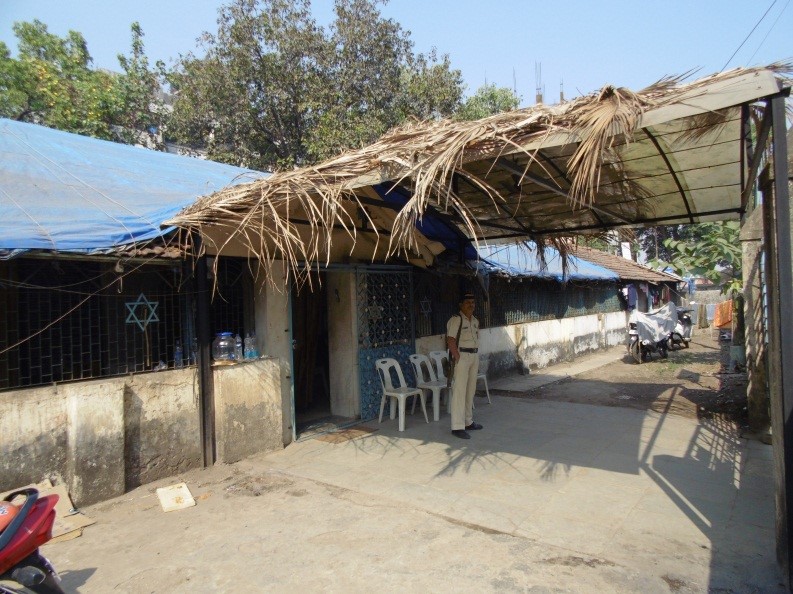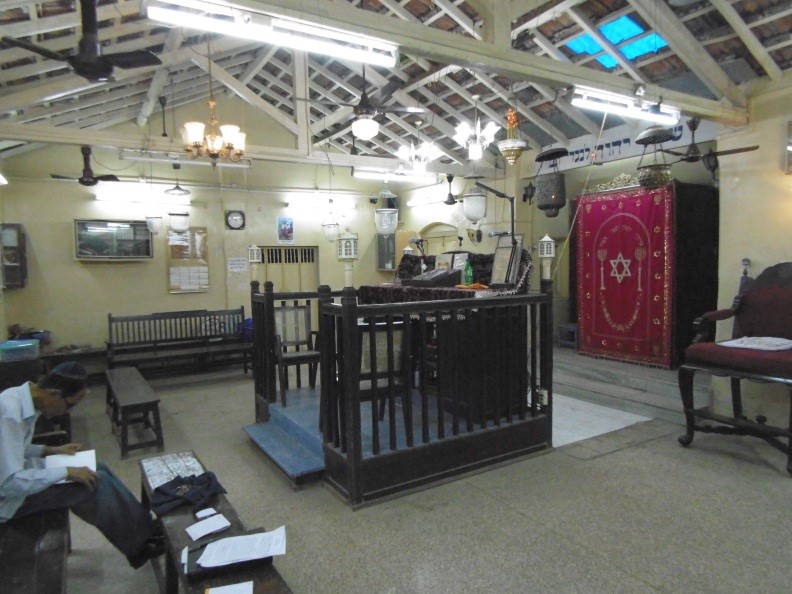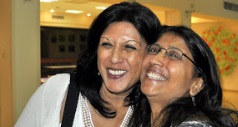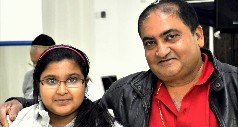KURLA PRAYER HALL (1946)
275, S. G. Barve Marg (also known as C. S. T. Road)
Opposite Buddha Colony
Kurla West
Maharashtra, INDIA
Located in the suburban Mumbai community of Kurla, this is still an active prayer hall with a small community, so visiting it is possible. Whereas the building’s caretaker, Moses Rajpurkar (shown in the picture below), does not use email, he can be contacted at 9867309825 to arrange a visit. Otherwise the synagogue most probably will be locked, so visitors should avoid showing up randomly. Today the Mumbai police are stationed at the building at all times, so casual hanging about the property is discouraged. The police do not have a key to the building. Kurla can be reached by taxi from central Mumbai, or a frequent (yet often crowded) commuter train can get a more adventurous visitor to the building site.
This prayer hall, located in Kurla West to the northeast of Mumbai at 275, S. G. Barve Marg (also known as C. S. T. Road) and opposite the Buddha Colony (formerly a Jewish colony with nearly two hundred families during the "1930s" and "40s"), was established in "1915" by the Bene Israel (Children of Israel) community living in the area. Other Bene Israel Jewish communities have long resided in central Mumbai and in the suburb of Thana to the north. Kurla is on a commuter rail service that terminates in central Mumbai, making it a convenient and desirable place to live.
The founding father of the Kurla Prayer Hall was Mr. Isaac Moses Ziradkar Kaji. From 1915 to 1922, prayer services were held at his own residence in Chunabhatti. Beginning in 1922 and continuing until 1933, the services were conducted in rented houses of another member of the congregation, Mr. Benjamin Shalom Sogavkar (Sogavson). From 1933 to 1946, the prayer services were relocated to a leased property known as the Old Court Building, which also belonged to Sogavkar (Sogavson). In 1946, Sogavkar (Sogavson) retained control of this property from the State of Maharashtra government, and this arrangement allowed the Kurla Bene Israel congregation to continue to use it as their prayer hall. Around this period, Mordekhai Aaron Mazgaonkar managed the Kurla Bene Israel Prayer Hall, and under his leadership it became more organized and active. In 1953, Sogavkar (Sogavson) passed away in the prayer hall. On the 30th of June 1954, the lease of the space was formally transferred to the Kurla Bene Israel Prayer Hall. Since that time, the building has been under the control of the congregation, and it has served as a center of religious and social life for the Jews of Kurla and nearby suburbs.
The prayer hall, with a wall separating it and the busy street, is housed within an understated, low-lying strip building dating to the early twentieth century. A continuous breezeway runs along the front, or eastern side of the building, and from this area the prayer hall and its support spaces are accessed. The long volume has a gabled roof covered in flat clay tiles. Marking the entrance to the prayer hall is a small gable featuring the name of the prayer hall in Marathi and English and a Magen David (Star of David).
Kurala Prayer Hall’s sanctuary is an intimately-scaled rectangular room with a pair of entry doors that are flanked with windows at the east elevation and a wooden heckal (ark) with another pair of shuttered windows to each side at the west elevation. The cabinet-like freestanding wooden heckal is set within a niche along the wall closest to Jerusalem as per synagogue convention. Flanking the heckal are two large chairs: one dedicated to the prophet Elijah, and the other used for the brit mila, or circumcision ceremony. The north area of the sanctuary has space for women’s seating according to Orthodox synagogue custom. In Bene Israel and general Indian synagogue tradition, the tebah (bimah/table from where the Torah is read and the service is led) is centrally placed. The Kurla Prayer Hall tebah is a raised platform surrounded by a wooden railing and marked by lighting fixtures at its four corners. Within the tebah is a wooden reader’s table draped as is usual in synagogues.
The chunam (plaster of polished lime and sand) walls of the prayer hall are painted pale yellow. Lighting sconces and framed displays of Hebrew verses hang from the walls, and above the heckal is Hebrew text. The floor of the prayer hall is paved with stone tiles. Typical to buildings in India of this scale and construction, Kurla Bene Israel Prayer Hall’s ceiling is open with painted wood roof trusses and rafters, and the undersides of the clay roof tiles are exposed. This ceiling design adds an open and spacious quality to the room. Hanging from the ceiling, in typical Indian synagogue fashion, is an assortment of glass and metal lighting fixtures and fans. Among these is the brass ner tamid, or light that always burns to indicate the presence of God. It hangs in front of the heckal. Another special light, also of brass, is for the prophet Elijah. These various-styled lighting fixtures and ceiling fans provide the room with a sense of place and character. Long wooden benches and plastic chairs provide seating for congregants and guests, and wooden bookcases line the walls of the sanctuary space. Framed Hebrew prayer verses, a clock, and other objects hang from the synagogue walls.
Over the years, so-called beautification efforts have been undertaken at Kurla Bene Israel Prayer Hall, and wall plaques listing the sponsors can be seen in the breezeway space. Kurla Prayer Hall remains an active and vital center of Jewish life for this Bene Israel enclave, and Friday night and Saturday morning prayer services, holiday events, and life-cycle celebrations are regularly held here. Visitors are always welcome.
May 2015 marked the centennial of the Kurla Bene Israel Prayer Hall. Leading up to this celebratory event, a fundraising effort was underway just before that time to cover repairs and upgrades to the building so that it can continue to serve the community for many years to come.

Exterior

Interior








